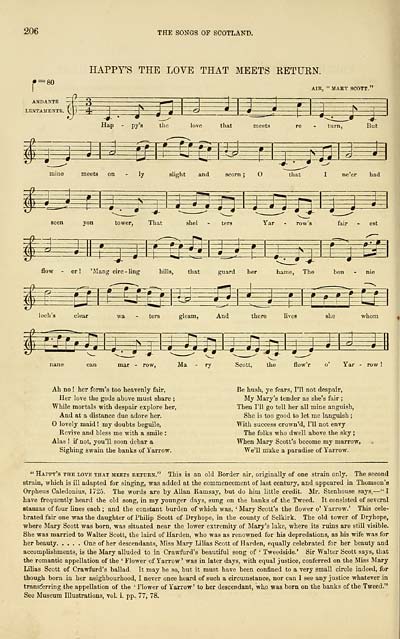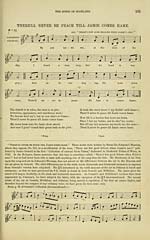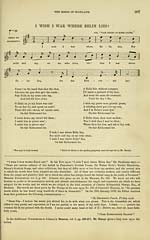Glen Collection of printed music > Printed music > Wood's edition of the songs of Scotland
(232) Page 206 - Happy's the love that meets return
Download files
Complete book:
Individual page:
Thumbnail gallery: Grid view | List view

206
THE SONGS OF SCOTLAND.
HAPPY'S THE LOVE THAT MEETS KETURN.
= 80
AIR, " MART SCOTT."
LENTAMENTK. (']) -j-
Hap - py's the love that
Sfe*=@^^
turn,
But
ight and acorn ; O
ne'er had
y -Q ] LttFP Z
Yar
fair
—4-
est
s
mm
^JT
w
it=
w
flow - er ! 'Jiang circ- ling hills, that guard her hame, The bon - nie
m
s
i=t
^32
^
DtZ*
^=i=P=
SE
fs=t
loch's clear
ters
gleam, And there lives
she
whom
K
W-r-»-
m
^
)=pt
22:
a
mar - row, Ma - ry Scott, the flow'r o' Yar - row !
Ah no ! her form's too heavenly fair,
Her love the gods above must share ;
While mortals with despair explore her,
And at a distance due adore her.
lovely maid ! my doubts beguile,
Revive and bless me with a smile :
Alas ! if not, you'll soon debar a
Sighing swain the banks of Yarrow.
Be hush, ye fears, I'll not despair,
My Mary's tender as she's fair ;
Then I'll go tell her all mine anguish,
She is too good to let me languish ;
With success crown'd, I'll not envy
The folks who dwell above the sky ;
When Mary Scott's become my marrow,
We'll make a paradise of Yarrow.
" Happy's the love that meets return." This is an old Border air, originally of one strain only. The second
strain, which is ill adapted for singing, was added at the commencement of last century, and appeared in Thomson's
Orpheus Caledonius, 1725. The words are by Allan Ramsay, but do him little credit. Mr. Stenhouse says, — "I
have frequently heard the old song, in my younger days, sung on the banks of the Tweed. It consisted of several
stanzas of four lines each ; and the constant burden of which was, ' Mary Scott's the flower o' Yarrow.' This cele-
brated fair one was the daughter of Philip Scott of Dryhope, in the county of Selkirk. The old tower of Dryhope,
■where Mary Scott was born, was situated near the lower extremity of Mary's lake, where its ruins are still visible.
She was married to Walter Scott, the laird of Harden, who was as renowned for his depredations, as his wife was for
her beauty One of her descendants, Miss Mary Lilias Scott of Harden, equally celebrated for her beauty and
accomplishments, is the Mary alluded to in Crawfurd's beautiful song of ' Tweedside.' Sir Walter Scott says, that
the romantic appellation of the ' Flower of Yarrow' was in later days, with equal justice, conferred on the Miss Mary
Lilias Scott of Crawfurd's ballad. It may be so, but it must have been confined to a very small circle indeed, for
though born in her neighbourhood, I never once heard of such a circumstance, nor can I see any justice whatever in
transferring the appellation of the ' Flower of Yarrow ' to her descendant, who was born on the banks of the Tweed."
See Museum Illustrations, vol. i. pp. 77, 78.
THE SONGS OF SCOTLAND.
HAPPY'S THE LOVE THAT MEETS KETURN.
= 80
AIR, " MART SCOTT."
LENTAMENTK. (']) -j-
Hap - py's the love that
Sfe*=@^^
turn,
But
ight and acorn ; O
ne'er had
y -Q ] LttFP Z
Yar
fair
—4-
est
s
mm
^JT
w
it=
w
flow - er ! 'Jiang circ- ling hills, that guard her hame, The bon - nie
m
s
i=t
^32
^
DtZ*
^=i=P=
SE
fs=t
loch's clear
ters
gleam, And there lives
she
whom
K
W-r-»-
m
^
)=pt
22:
a
mar - row, Ma - ry Scott, the flow'r o' Yar - row !
Ah no ! her form's too heavenly fair,
Her love the gods above must share ;
While mortals with despair explore her,
And at a distance due adore her.
lovely maid ! my doubts beguile,
Revive and bless me with a smile :
Alas ! if not, you'll soon debar a
Sighing swain the banks of Yarrow.
Be hush, ye fears, I'll not despair,
My Mary's tender as she's fair ;
Then I'll go tell her all mine anguish,
She is too good to let me languish ;
With success crown'd, I'll not envy
The folks who dwell above the sky ;
When Mary Scott's become my marrow,
We'll make a paradise of Yarrow.
" Happy's the love that meets return." This is an old Border air, originally of one strain only. The second
strain, which is ill adapted for singing, was added at the commencement of last century, and appeared in Thomson's
Orpheus Caledonius, 1725. The words are by Allan Ramsay, but do him little credit. Mr. Stenhouse says, — "I
have frequently heard the old song, in my younger days, sung on the banks of the Tweed. It consisted of several
stanzas of four lines each ; and the constant burden of which was, ' Mary Scott's the flower o' Yarrow.' This cele-
brated fair one was the daughter of Philip Scott of Dryhope, in the county of Selkirk. The old tower of Dryhope,
■where Mary Scott was born, was situated near the lower extremity of Mary's lake, where its ruins are still visible.
She was married to Walter Scott, the laird of Harden, who was as renowned for his depredations, as his wife was for
her beauty One of her descendants, Miss Mary Lilias Scott of Harden, equally celebrated for her beauty and
accomplishments, is the Mary alluded to in Crawfurd's beautiful song of ' Tweedside.' Sir Walter Scott says, that
the romantic appellation of the ' Flower of Yarrow' was in later days, with equal justice, conferred on the Miss Mary
Lilias Scott of Crawfurd's ballad. It may be so, but it must have been confined to a very small circle indeed, for
though born in her neighbourhood, I never once heard of such a circumstance, nor can I see any justice whatever in
transferring the appellation of the ' Flower of Yarrow ' to her descendant, who was born on the banks of the Tweed."
See Museum Illustrations, vol. i. pp. 77, 78.
Set display mode to: Large image | Transcription
Images and transcriptions on this page, including medium image downloads, may be used under the Creative Commons Attribution 4.0 International Licence unless otherwise stated. ![]()
| Special collections of printed music > Glen Collection of printed music > Printed music > Wood's edition of the songs of Scotland > (232) Page 206 - Happy's the love that meets return |
|---|
| Permanent URL | https://digital.nls.uk/91340527 |
|---|
| Description | Scottish songs and music of the 18th and early 19th centuries, including music for the Highland bagpipe. These are selected items from the collection of John Glen (1833 to 1904). Also includes a few manuscripts, some treatises, and other books on the subject. |
|---|
| Description | The Glen Collection and the Inglis Collection represent mainly 18th and 19th century Scottish music, including Scottish songs. The collections of Berlioz and Verdi collected by bibliographer Cecil Hopkinson contain contemporary and later editions of the works of the two composers Berlioz and Verdi. |
|---|

